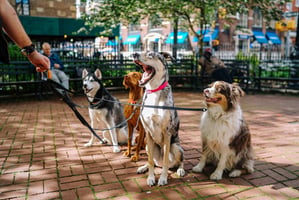Training a 4 month old puppy can be a challenging task, but with the right guidance and patience,...
Crate Training in an Apartment: A Comprehensive Guide
Crate training is a great way to house train your pup and teach them the limits of what they can and cannot do. For those living in an apartment, it can be a little tricky to make sure everything is done correctly. This guide will provide you with all the information you need to successfully crate train your pup in an apartment, from selecting the right crate to making sure you provide enough space for your pup to feel comfortable.
What Is Crate Training?
Crate training is a method of house training puppies and adult dogs. It involves placing your pup in a crate in order to teach them the boundaries of what they can and cannot do in a space. The crate should be large enough for them to stand up, turn around, and lie down comfortably. This method of training also helps to ensure that your pup is not destructive when left alone, as they will be confined to the crate.
Crate training is a great way to house train your pup and teach them the limits of what they can and cannot do.
Selecting the Right Crate
When selecting a crate for your pup, it is important to make sure it is the right size. You want to make sure it is large enough for them to stand up, turn around, and lie down comfortably. The crate should also be made from a durable material, such as metal or plastic, so that it can withstand your pup's chewing and scratching.
You should also make sure that the crate is outfitted with a comfortable bed or pad. This will provide your pup with a soft and cozy area to rest, which will help them feel more secure in their new space.
Where to Place the Crate
When setting up your pup's crate in an apartment, it is important to make sure it is in a place where they can feel comfortable and safe. You should place the crate in an area that is quiet and away from any busy or loud areas of the apartment. You also want to make sure that the crate is not in direct sunlight, as this can make it too hot for your pup to be comfortable in.
You should also make sure that the crate is not too close to the door, as this can make your pup feel too vulnerable and exposed. You should also try to set the crate up in a place where your pup can see you, as this will help them feel more secure.
Introducing Your Pup to the Crate
Once you have selected the right crate and set it up in the right place, it is time to introduce your pup to their new space. The best way to do this is to start by making the crate a positive and happy place. You can do this by placing their favourite toys and treats in the crate and allowing them to explore the space without forcing them in. You can also praise them when they go near the crate, as this will help them to associate the crate with positive feelings.
Once your pup is comfortable with the crate, you can start to get them used to spending time in it. You can start by leaving them in the crate for short periods of time while you are in the room. You can also give them treats or toys to keep them occupied while in the crate. This will help them to get used to being in the crate and can help to reduce any anxiety they may have.
Crate Training in an Apartment: Tips and Tricks
- Provide enough space: Make sure the crate is large enough for your pup to stand up, turn around, and lie down comfortably.
- Choose the right material: Select a durable material, such as metal or plastic, so that it can withstand your pup's chewing and scratching.
- Place the crate in a safe area: Put the crate in a quiet area away from any busy or loud areas of the apartment.
- Make the crate a positive space: Place your pup's favourite toys and treats in the crate and allow them to explore the space without forcing them in.
- Introduce them to the crate gradually: Start by leaving them in the crate for short periods of time while you are in the room and give them treats or toys to keep them occupied.
Creating a Routine
Once your pup is comfortable with the crate, it is important to create a routine for them. You should make sure that they have regular potty breaks, meals, and playtime. This will help them to understand when it is time to go to the bathroom, eat, and play. You should also make sure that they have enough exercise and stimulation throughout the day, as this will help to keep them calm and relaxed.
You should also make sure that you are consistent with your pup's crate training. This means that you should stick to the same routine day after day and not change it too often. This will help your pup to understand what is expected of them and make it easier for them to learn the rules.
Making Crate Training in an Apartment a Success
Crate training in an apartment can be tricky, but it doesn't have to be. By following the tips and tricks outlined in this guide, you can make sure that your pup is comfortable and safe in their new space. With the right crate and a consistent routine, you can successfully crate train your pup in an apartment and create a happy and harmonious living space for everyone.
By providing your pup with a safe and comfortable space, you can help them to feel secure and relaxed in their new home. With patience and consistency, you can successfully crate train your pup in an apartment and create a happy and harmonious living space for everyone. With the right crate and a consistent routine, you can successfully crate train your pup in an apartment and create a happy and harmonious living space for everyone.



